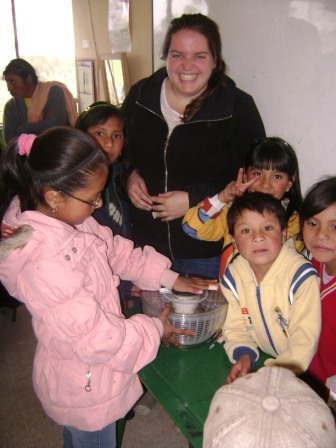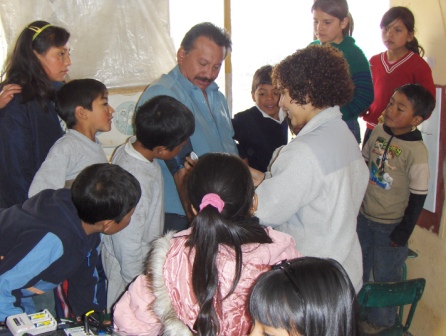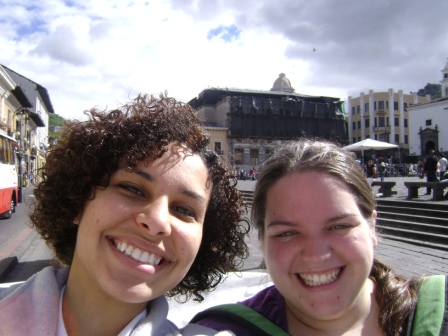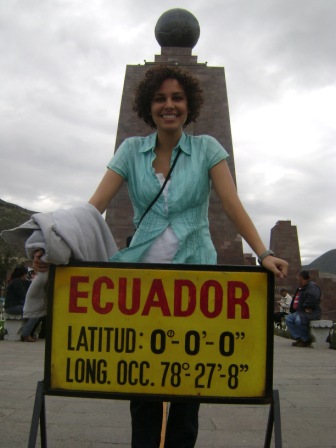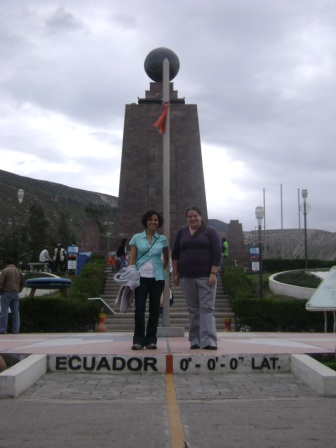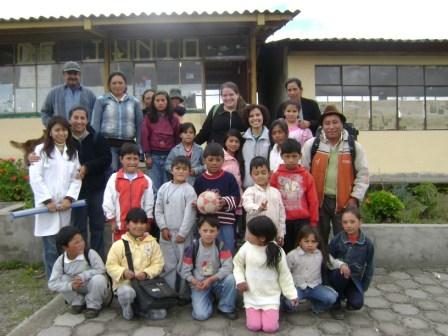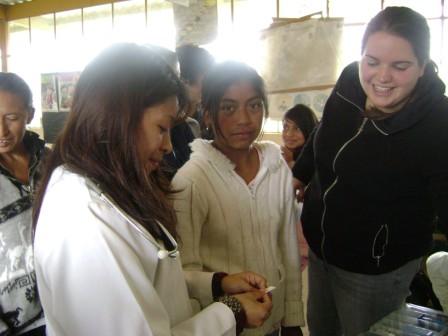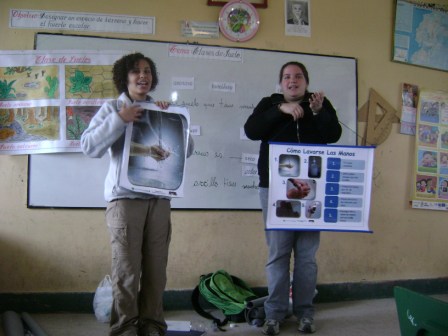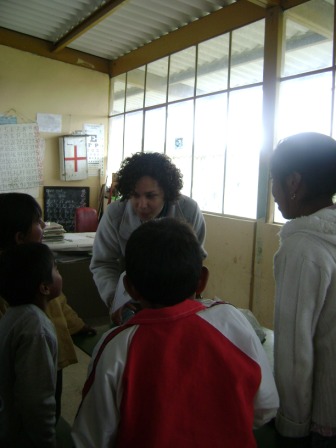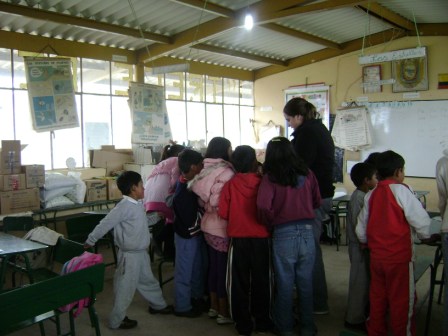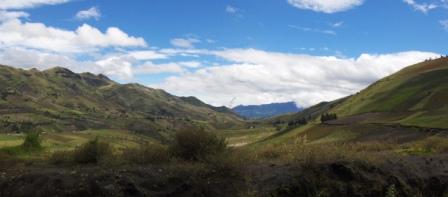A few last minute updates
El Reciclaje
The last week of our internship was a very busy and successful one. There was much left to do with our projects and the backpacks in preparation for Yvette’s and Dr. Oden’s arrival in Ecuador. At the beginning of the week, Lila and I went to Quito to make yet another trip to the printing place to pick up our educational booklets for the CHO pack and the Zipocrit Reader Card booklets. We also took this opportunity to bring the recycled items from the clinic Planchaloma to the recycling company in Quito. Unfortunately, it didn’t really work out the way I had planned. I had hoped that the company would buy the recyclables for a fairly reasonable price of at least a few dollars. However, when we brought the bags of items and the workers weighed them, the final price for all of the recyclables was only a 34 cents! We figured that a little money is better than no money at all, but when we saw that the taxi ride back cost more than we received, we wondered if this was an efficient way to recycle the items. In the end, we figured it just wasn’t worth it to waste gas to drive the items to a company who will only buy it for a few cents. However, later that day we discovered a huge recycling bin that belonged to Techniseguros, the office where Maria Alicia works. This turns out to be a much more convenient way for Maria Alicia to recycle the items from the clinics and more environmentally friendly because it saves on gas. Thus, I believe my recycling project has had a successful start and is sustainable in the communities as long as the health workers encourage the idea and Maria Alicia picks up the items during her visits to the clinics.
La Biblioteca

Lila’s library was also off to a very good start. We set up a check-out system in which every book is registered in a records book and contains a pocket with a red card that reads “You forgot to register me!” Then, once someone expresses interest in checking out a book, the health workers at the clinic will record the date and person’e name, remove the red card from the book and replace it with a green card that reads “Don’t forget to return me.” The system is very simple and organized, and the workers and patients caught on quickly. Lila also quickly gained a few loyal customers. A group of small kids had tracked her down one day while we were at an internet cafe in Planchaloma and asked her if they could please borrow some books. Lila was absolutely ecstatic and she walked with them to the clinic, where they each checked out 2 books from her library. This same group of kids not only come back about 3 times a day to get more books, but they also told all of their friends and siblings about the library and even brought them all to the clinic to show them. It’s really amazing to see the people in the surrounding communities so excited about the existence of a such a simple, convenient system in which they can read books for free. It’s refreshing and inspiring to see their thirst for knowledge and their desire to learn. Lila’s project has most definitely been successful so far. Hopefully, the doctors at the clinic are able to buy more books soon to add to the library’s collection; because pretty soon, those little kids will have read every book there!
The backpacks
The Lab-in-a-Backpack is now being put to good use in the clinic in Planchaloma as well as in Yatzaputzan, now that both clinics have lab techs there at least once a week to run tests. And after all of our hard work, the new and improved CHO pack was able to be left at the clinic in Yatzaputzan, containing all of the items that they had requested to be added to the pack. Now hopefully the backpack contains everything that they would need to go on a brigade in the surrounding communities. However, unlike the other 2 backpacks, the OB/GYN pack was not as successful. Many changes and revisions must be made to the pack before it is ready to use in these communities and clinics. But we have received a lot of feedback on the pack and pass this information onto the next team assigned to work on the pack so that, in the future, the pack can be useful and ready to use in Ecuador.
In other news…
Dr. Oden and Yvette finally made it to Ecuador! We were so excited to see them pull up in front of the clinic in Planchaloma. But when they arrived, everyone got right down to business. They met the new lab tech, Esperanza, who will be working with the Lab-in-a-Backpack every Saturday at the clinic. She made sure to let them know how much she enjoys working with the backpack, which contains almost everything needed to run her usual tests. She also voiced her approval of Lila’s Sally centrifuge. She and the doctors all stated that they wished that we could’ve left Sally with them to use at the clinic and were a little upset when we told them that we couldn’t. Dr.Oden also brought m syringe clips with her, so we were finally able to demonstrate the clips to the doctors and promoters in Planchaloma. They were amazed at the simplicity of the concept and ease-of-use of the clip itself. They told us that they want a whole bunch of them of various sizes for both the 3mL and 5mL syringes. When I heard this, I could not have been happier. Of course, there is still a lot of work to be done to perfect them, but hopefully in the near future we will be able to send the desired amount of clips to the clinics.






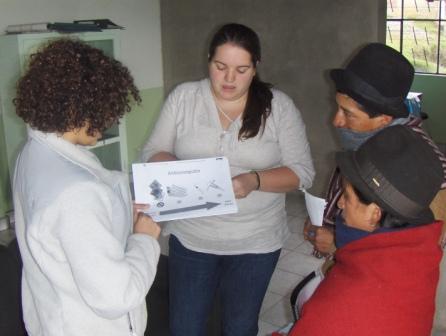
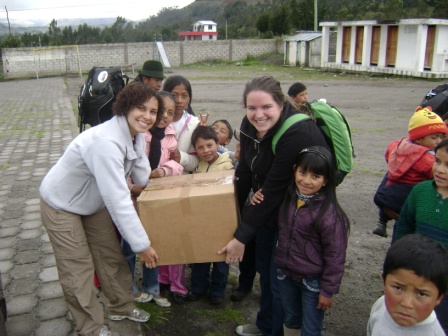 Wednesday marked our first day back in Planchaloma and another medical brigade to Yugsiche Alto. This time we were accompanied by Maria Alicia, Monica, a gynecologist at the clinic, and Don Juan, another health promoter from Planchaloma. When our truck pulled up to the school, we were greeted by a mass of smiling kids running up to greet and hug us. They even remembered our names! Once we got them to settle down a bit, Maria Alicia reviewed with the kids and parents what Lila and I had taught them the last week about hand hygiene and recycling. And they did very well on their little quiz! They remembered the important points that we covered the in our lesson week before. This is great news for Lila and me: our ‘charlitas’ with the kids are a success! The kids are actually learning and retaining the knowledge that we give them. Now, we just hope that they are using it as well.
Wednesday marked our first day back in Planchaloma and another medical brigade to Yugsiche Alto. This time we were accompanied by Maria Alicia, Monica, a gynecologist at the clinic, and Don Juan, another health promoter from Planchaloma. When our truck pulled up to the school, we were greeted by a mass of smiling kids running up to greet and hug us. They even remembered our names! Once we got them to settle down a bit, Maria Alicia reviewed with the kids and parents what Lila and I had taught them the last week about hand hygiene and recycling. And they did very well on their little quiz! They remembered the important points that we covered the in our lesson week before. This is great news for Lila and me: our ‘charlitas’ with the kids are a success! The kids are actually learning and retaining the knowledge that we give them. Now, we just hope that they are using it as well. During the brigade, the doctors from the clinic, including Lorena and Monica, took every child’s height and weight. Sandra, a health promoter in training, sat behind a small table and gave the kids bottles of multivitamins. Monica also gave all of the kids de-parasiting pills, which essentially will detox them of all the parasites that linger in their bodies and could potentially cause them extreme harm. Lila showed the ever-curious kids all of the devices in the backpack and how they worked. She also took care of various cuts, scrapes, and burns that the kids complained to her about by using the First Aid items in the CHO pack. After the wounds were taken care of, the kids found serious interest in Sally, which she demonstrated to them and let them take turns pushing the button for the allotted 10 minutes. I had most, if not all, of the adults ask me to take their blood pressure and glucose, a few of them telling me they were concerned about their health because of diabetes. I used the glucometer, test strips and antiseptic wipes from the Lab-in-a-Backpack to test their blood glucose levels and also used the blood pressure cuff from this backpack. There were no more lancets in the Lab-in-a-Backpack, so I used the ones from the CHO pack. I tested over 25 people and of these, one woman had a glucose level of 319. This is extremely high, given that normal is between 80 and 120. When I told her this, she said she knew that she has diabetes and has painful headaches all of the time. I asked her if she had medicine for this or if she had even been to the clinic to see a doctor about her condition. She responded no because she didn’t know that they could help her or give her medicine.
During the brigade, the doctors from the clinic, including Lorena and Monica, took every child’s height and weight. Sandra, a health promoter in training, sat behind a small table and gave the kids bottles of multivitamins. Monica also gave all of the kids de-parasiting pills, which essentially will detox them of all the parasites that linger in their bodies and could potentially cause them extreme harm. Lila showed the ever-curious kids all of the devices in the backpack and how they worked. She also took care of various cuts, scrapes, and burns that the kids complained to her about by using the First Aid items in the CHO pack. After the wounds were taken care of, the kids found serious interest in Sally, which she demonstrated to them and let them take turns pushing the button for the allotted 10 minutes. I had most, if not all, of the adults ask me to take their blood pressure and glucose, a few of them telling me they were concerned about their health because of diabetes. I used the glucometer, test strips and antiseptic wipes from the Lab-in-a-Backpack to test their blood glucose levels and also used the blood pressure cuff from this backpack. There were no more lancets in the Lab-in-a-Backpack, so I used the ones from the CHO pack. I tested over 25 people and of these, one woman had a glucose level of 319. This is extremely high, given that normal is between 80 and 120. When I told her this, she said she knew that she has diabetes and has painful headaches all of the time. I asked her if she had medicine for this or if she had even been to the clinic to see a doctor about her condition. She responded no because she didn’t know that they could help her or give her medicine. 